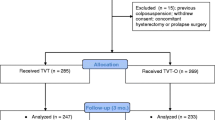Abstract
Introduction and hypothesis
Preliminary reports show promising data on tension-free vaginal tape (TVT) in women with lower motor neuron lesion (LMNL) presenting with stress urinary incontinence (SUI). We compared efficacy and safety of TVT to pubovaginal sling (PVS) in treating SUI in women with LMNL.
Methods
This was a pilot, nonrandomized clinical trial evaluating women with SUI associated with pathology at or below S2 spinal segment. Failure was defined as leakage of urine during cough test at 250 ml bladder volume. Primary outcome was time to treatment failure based on positive cough stress test. Other outcomes were Urogenital Distress Inventory Short Form-6 (UDI-6), Incontinence Impact Questionnaire Short Form-7 (IIQ-7) and urodynamics. Regression models were used to adjust for confounders.
Results
The study evaluated 40 women: 20 TVT and 20 PVS, and cure rates were 80 and 85 %, respectively. Time to treatment failure in the TVT group was comparable with the PVS group, with an unadjusted hazard ratio (HR) of 2.90 [95 % confidence interval (CI), 0.61–15.42, P = 0.154]. After adjusting for confounders, adjusted HR for treatment failure was 1.04 (95 % CI, 0.12–8.66, likelihood ratio chi-square P = 0.973). Both groups showed significant reductions in UDI-6 and IIQ-7 scores after surgery. One patient had mesh erosion in the TVT group.
Conclusions
TVT is feasible, effective and safe for women with LMNL presenting with SUI, with comparable treatment outcomes to PVS. TVT might be of benefit to women who do not use clean intermittent catheterization (CIC) at baseline.


Similar content being viewed by others
Abbreviations
- TVT :
-
tension-free vaginal tape
- PVS :
-
Pubovaginal Sling
- nSUI :
-
neurogenic stress urinary incontinence
- UDI-6 :
-
Urogenital Distress Inventory Short Form−6
- IIQ-7 :
-
Incontinence Impact Questionnaire Short Form−7
- PVR :
-
postvoid residual urine volume
- CIC :
-
Clean intermittent self catheterization
References
Haylen BT, de Ridder D, Freeman RM et al (2010) An International Urogynecological Association (IUGA)/International Continence Society (ICS) joint report on the terminology for female pelvic floor dysfunction. Int Urogynecol J 21:5–26
El-Azab AS, Mohamed EM, Sabra HI (2007) The prevalence and risk factors of urinary incontinence and its influence on the quality of life among Egyptian women. Neurourol Urodyn 26:783–788
Delancey JO (2002) Fascial and muscular abnormalities in women with urethral hypermobility and anterior vaginal wall prolapse. Am J Obstet Gynecol 187:93–98
Petros PE (1998) The pubourethral ligaments–an anatomical and histological study in the live patient. Int Urogynecol J Pelvic Floor Dysfunct 9:154–157
Harrop JS, Hunt GE Jr, Vaccaro AR (2004) Conus medullaris and cauda equina syndrome as a result of traumatic injuries: management principles. Neurosurg Focus 16:e4
Fidas A, MacDonald HL, Elton RA et al (1988) Neurophysiological measurements in patients with genuine stress incontinence of urine and the relation of neurogenic defects to the presence of spina bifida occulta. Br J Urol 62:46–50
Watanabe T, Chancellor MB, Rivas DA (1998) Neurogenic voiding dysfunction. In: Nitti VW (ed) Practical Urodynamics. W.B. Saunders Company, Philadelphia, pp 142–146
Daneshmand S, Ginsberg DA, Bennet JK et al (2003) Puboprostatic sling repair for treatment of urethral incompetence in adult neurogenic incontinence. J Urol 169:199–202
De Vocht TF, Chrzan R, Dik P et al (2010) Long-term results of bulking agent injection for persistent incontinence in cases of neurogenic bladder dysfunction. J Urol 183:719–723
Chartier-Kastler E, Van Kerrebroeck P, Olianas R et al (2011) Artificial urinary sphincter (AMS 800) implantation for women with intrinsic sphincter deficiency: a technique for insiders? BJU Int 107:1618–1626
Austin PF, Westney OL, Leng WW et al (2001) Advantages of rectus fascial slings for urinary incontinence in children with neuropathic bladders. J Urol 165:2369–2371
Gormley EA, Bloom DA, McGuire EJ et al (1994) Pubovaginal slings for the management of urinary incontinence in female adolescents. J Urol 152:822–825
Chung E, Cartmill RA (2010) 25-year experience in the outcome of artificial urinary sphincter in the treatment of female urinary incontinence. BJU Int 106:1664–1667
Hamid R, Khastgir J, Arya M et al (2003) Experience of tension-free vaginal tape for the treatment of stress incontinence in females with neuropathic bladders. Spinal Cord 41:118–121
Abdul-Rahman A, Attar KH, Hamid R et al (2010) Long-term outcome of tension-free vaginal tape for treating stress incontinence in women with neuropathic bladders. BJU Int 106:827–830
El-Azab AS, Mascha EJ (2009) Arabic validation of the urogenital distress inventory and adapted incontinence impact questionnaires-short forms. Neurourol Urodyn 28:33–39
Schafer W, Abrams P, Liao L et al (2002) Good urodynamic practices: uroflowmetry, filling cystometry, and pressure-flow studies. Neurourol Urodyn 21:261–274
Chaikin DC, Rosenthal J, Blaivas JG (1998) Pubovaginal fascial sling for all types of stress urinary incontinence: long-term analysis. J Urol 160:1312–1316
Lee E, Nitti VW, Brucker BM (2012) Midurethral slings for all stress incontinence: a urology perspective. Urol Clin N Am 39:299–310
Athanasopoulos A, Gyftopoulos K, McGuire EJ (2012) Treating stress urinary incontinence in female patients with neuropathic bladder: the value of the autologous fascia rectus sling. Int Urol Nephrol 44:1363–1367
Conflicts of interest
None.
Author information
Authors and Affiliations
Corresponding author
Rights and permissions
About this article
Cite this article
El-Azab, A.S., El-Nashar, S.A. Midurethral slings versus the standard pubovaginal slings for women with neurogenic stress urinary incontinence. Int Urogynecol J 26, 427–432 (2015). https://doi.org/10.1007/s00192-014-2521-8
Received:
Accepted:
Published:
Issue Date:
DOI: https://doi.org/10.1007/s00192-014-2521-8




